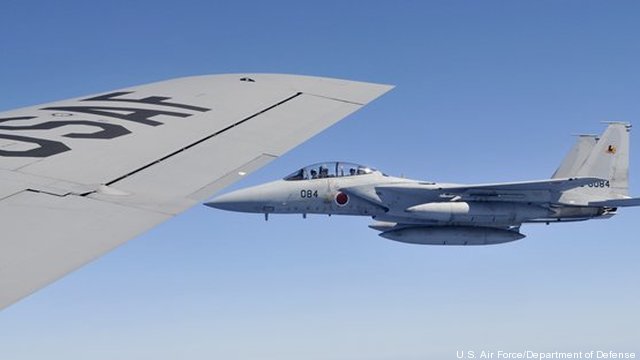Airborne Refueling Pact Paves Way For Regional Push Against China
Posted on
 Washington: Another memorandum signed by two governments. Yawn. Well, usually. But when the Japanese government confirmed that it would now allow its air forces to refuel American warplanes as part of an agreement signed between the two countries last October it took on an entirely new meaning.
Washington: Another memorandum signed by two governments. Yawn. Well, usually. But when the Japanese government confirmed that it would now allow its air forces to refuel American warplanes as part of an agreement signed between the two countries last October it took on an entirely new meaning.
The year-old pact between the Air Force and the Japanese military may now play an important role in Pacific power struggles as Japan and other territorial powers look to check recent Chinese aggression in the region.
Those refueling operations would only be done during joint exercises between the two countries, and would not be used to support ongoing U.S. operations in the region, according to the October 2010 memorandum of understanding.
To date, no U.S. fighters have been refueled by Japanese tankers for two reasons: Japan did not have tankers that could refuel American aircraft and Tokyo saw those operations as violating its strict self-defense only policy on military action, DoD spokeswoman Cmdr. Leslie Hull-Ryde said yesterday in an e-mail.
But with this week’s announcement, along with the four Boeing-built KC-767 aerial tankers that are now in the Japanese fleet, the Asian nation now has the means and authority to begin filling up U.S. jets in the Pacific.
This comes as China is aggressively asserting its military will among its regional neighbors in the Pacific.
Allowing American warplanes to refuel off of Japanese tankers — even only during exercises — could be the first step in a unified, regional effort to push back against that aggression, and send a clear message back to Beijing, one analyst said.
“There is an appetite to change” the long-standing, defense-centric stance that has dominated the Japanese military since the end of World War II, Mike Green, a Japanese military expert at the Center for Strategic and International Studies, said.
A decade ago, there was no way Tokyo would have agreed to refuel American fighters even if they had the means to do so, he said.
That appetite for change has been spurred in no small part by the possible threats posed by North Korea and China, he said.
“Japan continues to make strides forward . . . when it comes to making their self-defense forces play a stronger global role,” Patrick Cronin, an expert in Asian-Pacific security issues at the Center for A New American Security, told me.
Aside from the agreement on aerial refueling, American and Japanese air forces are also looking to co-locate their forces at Yokota Air Base while boosting cooperation at Atsugi and Misawa Air Bases, Cronin said.
This regional effort, Green noted, would probably not result in a “NATO in Asia” but the move does indicate the realization by Japan and others regional powers that a joint strategy is the only viable way to check Beijing’s moves in the Pacific, according to Green. “Jointness is a capability,” especially in light of the defense budget crunches that Washington and Tokyo are facing, he said.
At the tactical level, this close cooperation between Japan and the US would ensure that, if the time came, they would be able to fly and fight together, Cronin said. “The reality is that if there were a crisis tomorrow that invoked the alliance, both defense forces would have a steep learning curve with respect to some combined operations,” he said. The aerial refueling exercises covered under the MOU will go a long way to closing that gap.
Subscribe to our newsletter
Promotions, new products and sales. Directly to your inbox.
